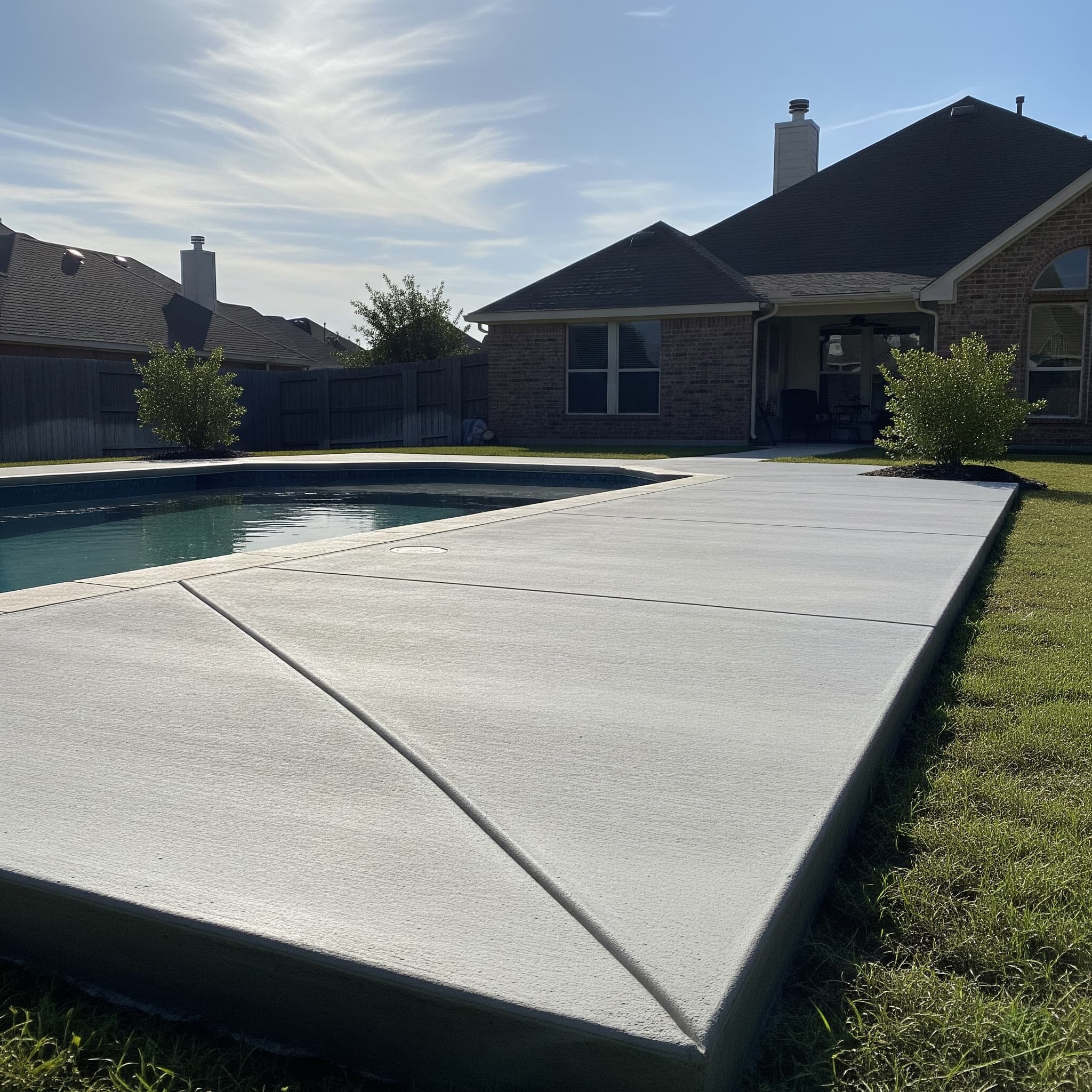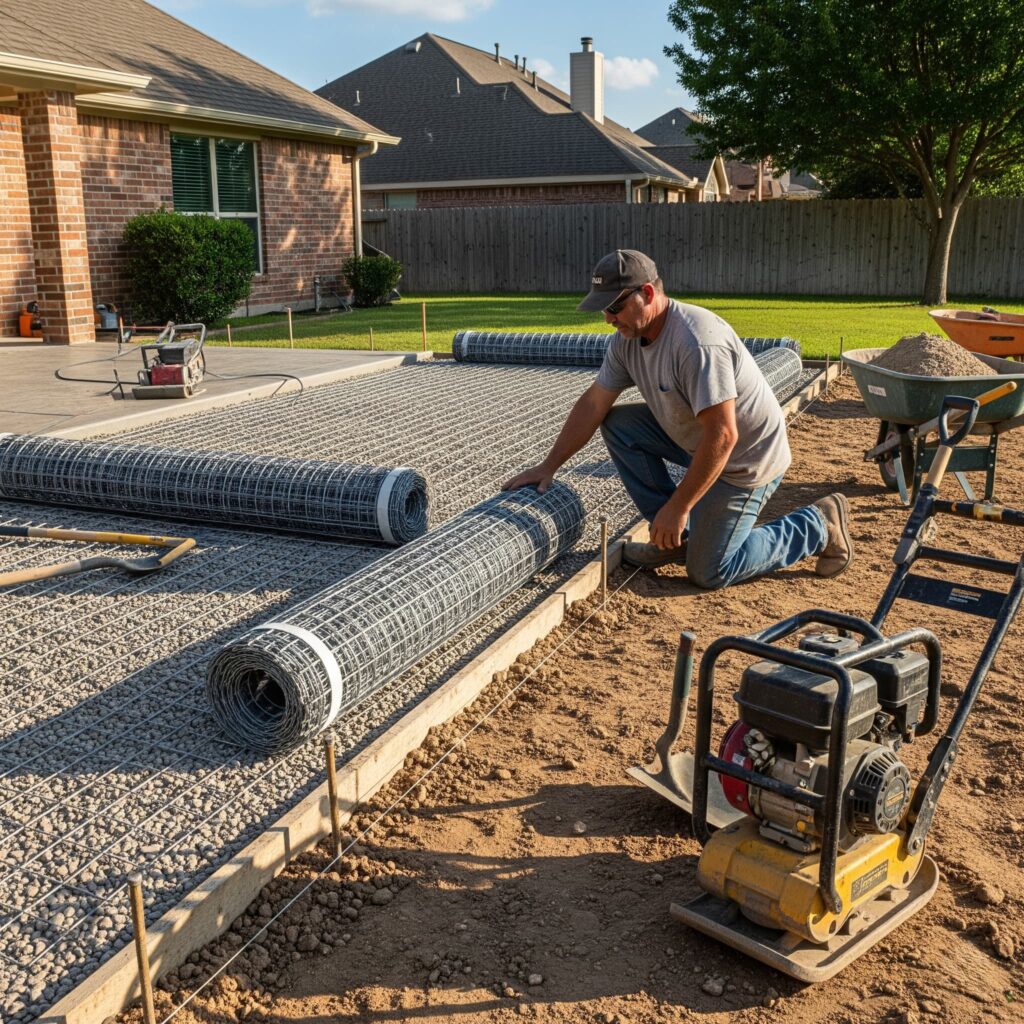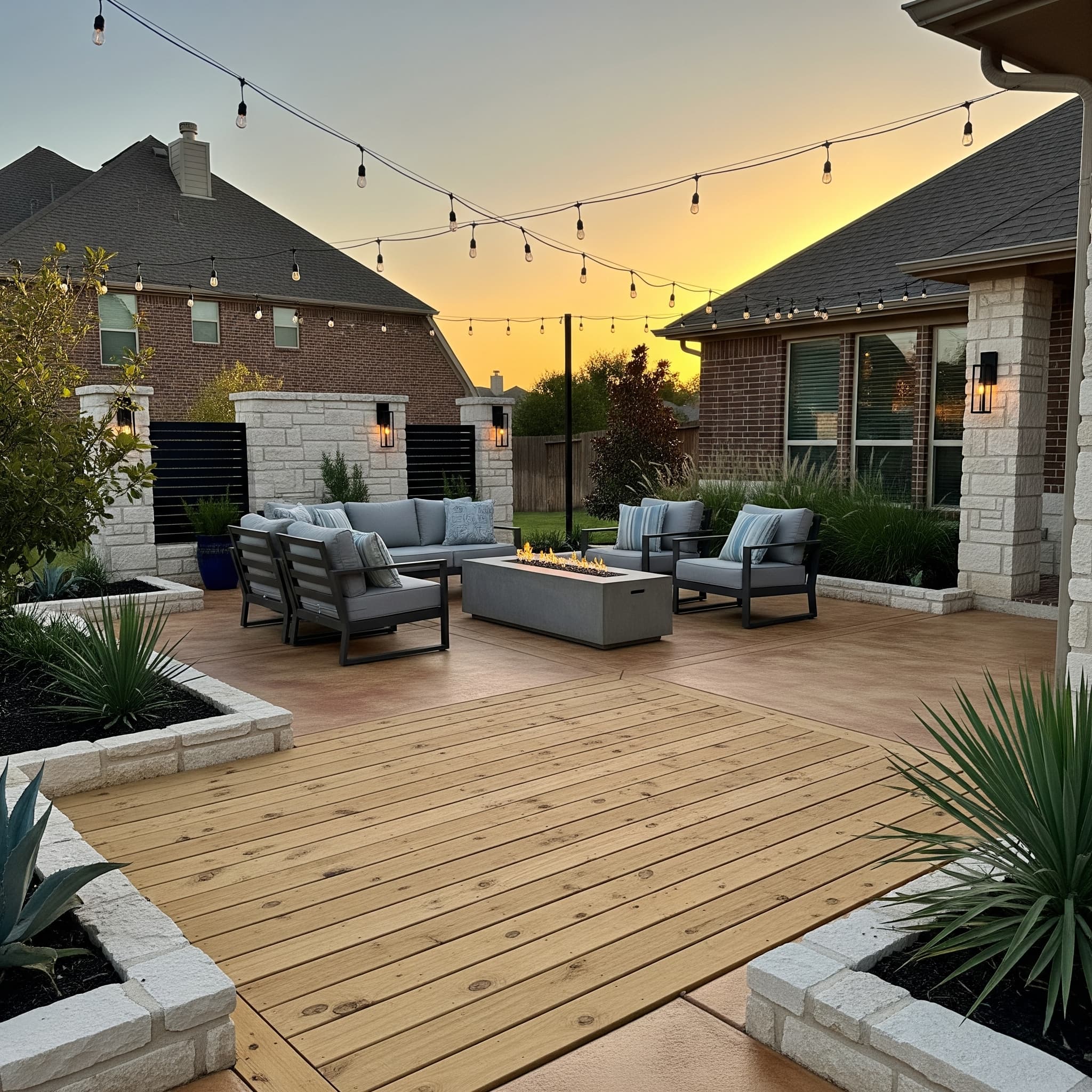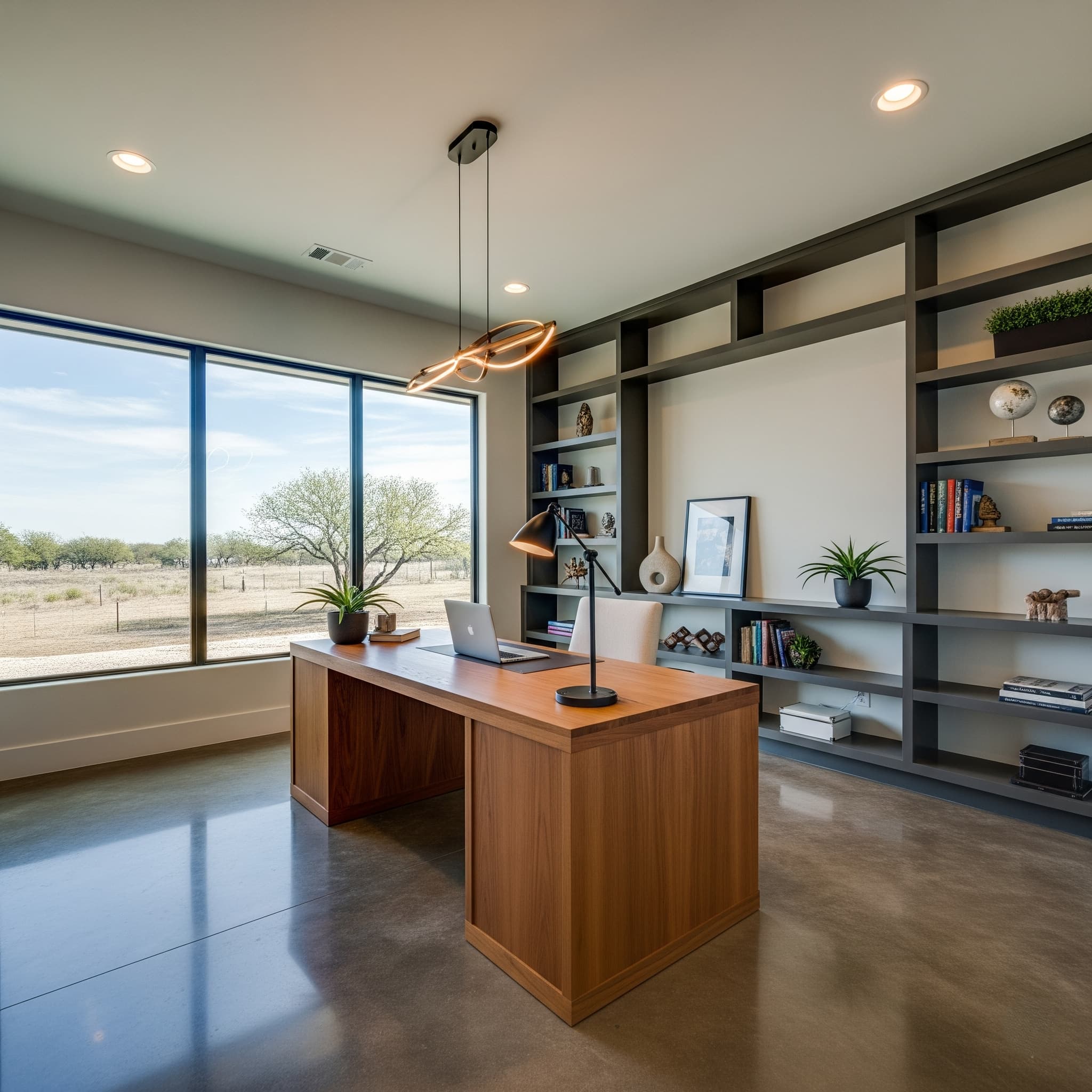
Stamped Concrete Patio: Prevent Settlement & Cracks
Stamped Concrete Patio
Preventing settlement and cracks in stamped concrete patios requires understanding Grand Prairie’s unique soil conditions and implementing proper installation techniques from the start. The expansive clay soils common throughout North Texas pose specific challenges that demand professional expertise and proven prevention strategies. Proper soil preparation, adequate reinforcement, and quality concrete mix designs work together to create durable installations that withstand local climate variations. Homeowners who invest in preventive measures during initial installation avoid costly repairs and maintain beautiful outdoor spaces for decades. Professional contractors familiar with Grand Prairie’s soil characteristics provide the expertise necessary to ensure long-term patio performance and satisfaction.

Understanding Grand Prairie Soil Challenges
Expansive Clay Soil Properties
Expansive clay soil in Grand Prairie contains smectite clay that causes dramatic volume changes based on moisture content. During wet periods, clay soils can expand significantly, exerting pressure on concrete surfaces from below. Conversely, extended dry spells cause clay to shrink, creating voids beneath patios that lead to settlement and potential cracking.
These soil movements particularly affect areas near Joe Pool Lake and throughout the established neighborhoods where clay content remains consistently high. Understanding these characteristics allows contractors to design installation methods that accommodate natural soil behavior while protecting decorative concrete investments.
Seasonal Weather Impact
Grand Prairie’s climate alternates between periods of heavy rainfall and extended drought conditions that directly influence soil stability. Spring rains saturate clay soils, causing expansion that puts upward pressure on concrete patios. Summer heat creates opposite conditions, with shrinking soils that remove support from patio foundations.
Temperature fluctuations also contribute to concrete stress through expansion and contraction cycles. Professional installations account for these predictable patterns through proper joint placement and reinforcement strategies that accommodate natural movement without compromising structural integrity.
Proper Site Preparation Techniques
Excavation and Grading Standards
Proper site preparation begins with excavation to appropriate depths that remove unstable surface soils and organic materials. Professional contractors typically excavate 6 to 8 inches below finished patio grade, ensuring adequate space for base materials and concrete thickness requirements.
Grading establishes proper drainage patterns that direct water away from patio areas, preventing moisture accumulation that could cause soil movement. Properties near EpicCentral and throughout Grand Prairie’s residential areas benefit from careful attention to drainage design that considers existing topography and neighboring structures.
Base Material Selection and Compaction
Quality-based materials provide stable foundations that distribute patio loads evenly across prepared soil surfaces. Crushed limestone or recycled concrete base offers excellent stability when properly compacted to 95% standard Proctor density or higher.
Mechanical compaction using plate compactors or vibratory rollers ensures uniform density throughout the base layer. This process eliminates air voids and creates firm surfaces that resist settlement under concrete loads. Base thickness typically ranges from 4 to 6 inches, depending on soil conditions and intended patio use.
Reinforcement Strategies for Crack Prevention
Steel Reinforcement Options
Rebar must be used in North Texas, no exceptions. Professional contractors use a minimum 4-inch thickness for all regular concrete slabs and incorporate steel reinforcement appropriate for local soil conditions. Welded wire mesh provides crack control for smaller patios, while larger installations benefit from rebar grid systems.
Proper reinforcement placement positions steel at or slightly above mid-slab depth to maximize effectiveness. Reinforcing concrete with steel rebar or welded wire mesh provides many benefits, including crack control, the need for fewer control joints, and increased structural strength and impact resistance.
Fiber Reinforcement Benefits
Synthetic fibers mixed into concrete provide additional crack resistance, particularly for plastic shrinkage cracking that occurs during initial curing. Polypropylene fibers distribute throughout the concrete matrix, creating three-dimensional reinforcement that works at the microscopic level.
Fiber reinforcement proves especially valuable for stamped concrete, where surface textures may create stress concentration points. Combined with traditional steel reinforcement, fibers provide comprehensive protection against various cracking mechanisms that could compromise decorative patterns.
Concrete Mix Design Considerations
Strength and Durability Requirements
High-quality concrete mixes designed for Grand Prairie’s climate conditions incorporate proper cement content, aggregate selection, and water-cement ratios that optimize strength and durability. Professional contractors specify a minimum 4000 PSI concrete with appropriate air entrainment for freeze-thaw protection.
Proper concrete mix composition includes 10-15% cementitious material, 60-75% aggregate, and 15-20% water ratios that provide workability while maintaining strength characteristics. Quality control during batching ensures consistent performance across entire patio installations.
Admixtures for Enhanced Performance
Modern concrete admixtures improve workability, reduce shrinkage, and enhance durability characteristics important for stamped concrete applications. Plasticizers allow reduced water content while maintaining the workability necessary for detailed stamping procedures.
Shrinkage-reducing admixtures minimize volume changes during curing, reducing crack potential in decorative installations. These chemical additions prove particularly valuable for patios near Grand Prairie Stadium and other high-visibility locations where appearance remains paramount.
Installation Best Practices
Timing and Weather Considerations
Optimal concrete placement occurs during moderate temperature and humidity conditions that allow proper hydration and curing. Extreme heat accelerates setting times, potentially compromising stamping quality, while cold weather extends curing periods and may require protection measures.
Professional contractors monitor weather forecasts and adjust installation schedules accordingly. This planning ensures adequate time for stamping procedures while preventing rapid moisture loss that could cause surface defects or pattern irregularities.
Control Joint Planning
Strategic control joint placement directs crack formation into predetermined locations where they remain less visible and structurally acceptable. Joints are typically spaced at intervals equal to 24 to 30 times the slab thickness, creating manageable panel sizes that accommodate natural concrete movement.
Decorative saw-cutting creates clean joint lines that complement stamped patterns while serving essential crack control functions. Proper joint sealing prevents water infiltration that could undermine base materials or contribute to soil movement beneath patios.
Curing and Protection Methods
Moisture Management During Curing
Proper curing maintains adequate moisture levels for concrete hydration while preventing rapid surface drying that leads to plastic shrinkage cracking. Curing compounds or moisture-retaining covers protect stamped surfaces during critical early strength development periods.
Grand Prairie’s variable humidity and temperature conditions require adaptive curing strategies that respond to actual site conditions. Professional contractors adjust protection methods based on weather patterns and project-specific requirements that ensure optimal strength development.
Traffic and Load Restrictions
Concrete reaches about 70% of its strength in 7 days and typically is at its full expected strength within 28 days. The initial set allows foot traffic after 24-48 hours, while full loading requires a minimum 7-day waiting period for residential applications.
Heavy equipment or furniture placement should wait for complete strength development to prevent surface damage or internal stress concentrations. Clear communication with homeowners about these restrictions prevents premature loading that could compromise long-term performance.
Drainage and Moisture Management
Surface Drainage Design
Effective drainage systems prevent water accumulation that contributes to soil movement and concrete deterioration. Proper slope design directs surface water away from patio areas toward appropriate collection or disposal points.
Integration with existing drainage patterns protects both new patios and surrounding landscape elements. Properties throughout the Lynn Creek Park area particularly benefit from comprehensive drainage planning that addresses topographical challenges and seasonal water flow patterns.
Subsurface Moisture Control
French drains and other subsurface drainage systems manage groundwater levels that could affect soil stability beneath concrete patios. These systems prove especially valuable in areas with known drainage challenges or where neighboring construction has altered natural water flow patterns.
Proper installation includes appropriate filter fabrics and drain materials that maintain long-term effectiveness without clogging. Regular maintenance ensures continued performance throughout the system’s design life.
Long-term Maintenance Strategies
Sealing and Protection
Quality sealers protect stamped concrete from moisture penetration, chemical damage, and UV degradation that could compromise both appearance and structural integrity. Professional-grade sealers applied at appropriate intervals maintain surface protection while preserving decorative patterns.
Resealing schedules typically range from 3-5 years, depending on traffic levels, weather exposure, and sealer types. Regular maintenance protects the investment value while maintaining aesthetic appeal throughout the patio’s service life.
Crack Monitoring and Repair
Regular inspection identifies minor cracks before they develop into major structural problems requiring extensive repairs. Early intervention through professional crack sealing prevents water infiltration and further deterioration.
Professional repair techniques match existing patterns and colors, maintaining visual continuity across repaired areas. Prompt attention to minor issues prevents costly replacement projects while preserving property values throughout Grand Prairie’s competitive real estate market.
Professional Installation Benefits
Local Expertise and Experience
Professional contractors familiar with Grand Prairie’s soil conditions, climate patterns, and building requirements provide expertise that DIY installations cannot match. Local knowledge prevents common mistakes while ensuring compliance with municipal codes and standards.
Experienced installation teams understand timing requirements, material specifications, and quality control procedures essential for successful stamped concrete projects. This expertise proves particularly valuable for complex installations that integrate multiple decorative elements.
Quality Assurance and Warranties
Professional installations include quality assurance protocols that verify proper materials, procedures, and finished results meet industry standards. Written warranties provide protection against defects and demonstrate contractor confidence in their workmanship.
We at Grand Prairie Concrete Pros understand the critical importance of proper soil preparation, reinforcement design, and installation procedures that prevent settlement and cracking in stamped concrete patios. Our team’s extensive experience with local soil conditions and climate challenges ensures installations that provide lasting beauty and performance. From initial site evaluation through final sealing, we implement proven techniques that protect your investment while creating stunning outdoor spaces that enhance property value and family enjoyment.



